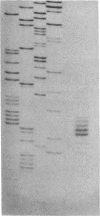Abstract
The osteocalcin gene encodes a 6-kDa polypeptide, which represents one of the most abundant noncollagenous bone proteins, and the present studies establish that osteocalcin mRNA is detected only in bone tissue. An osteocalcin gene was isolated from a rat genomic DNA library, and sequence analysis indicated that the mRNA is represented in a 953-nucleotide segment of DNA consisting of four exons and three introns. A modular organization of the 5' flanking sequences of the gene is reflected by the presence of at least three classes of regulatory elements, which include the following: (i) RNA polymerase II canonical sequences; (ii) a series of consensus sequences for hormone receptor binding sites and cyclic nucleotide responsive elements consistent with physiologic expression of the osteocalcin gene; and (iii) a 24-nucleotide sequence in the proximal promoter region with a CAAT motif as a central element. We have designated this highly conserved sequence as an "osteocalcin box" since only 2 nucleotide substitutions are found in the rat and human osteocalcin genes. We have demonstrated two factors regulating osteocalcin gene expression. First, a 200-fold increase occurs in normal fetal calvaria osteoblasts producing a mineralizing matrix, compared to confluent osteoblasts in a nonmineralizing matrix. Second, contained within the 600 nucleotides immediately upstream from the transcription start site are sequences that support a 10-fold stimulated transcription of the gene by 1,25-dihydroxyvitamin D.
Full text
PDF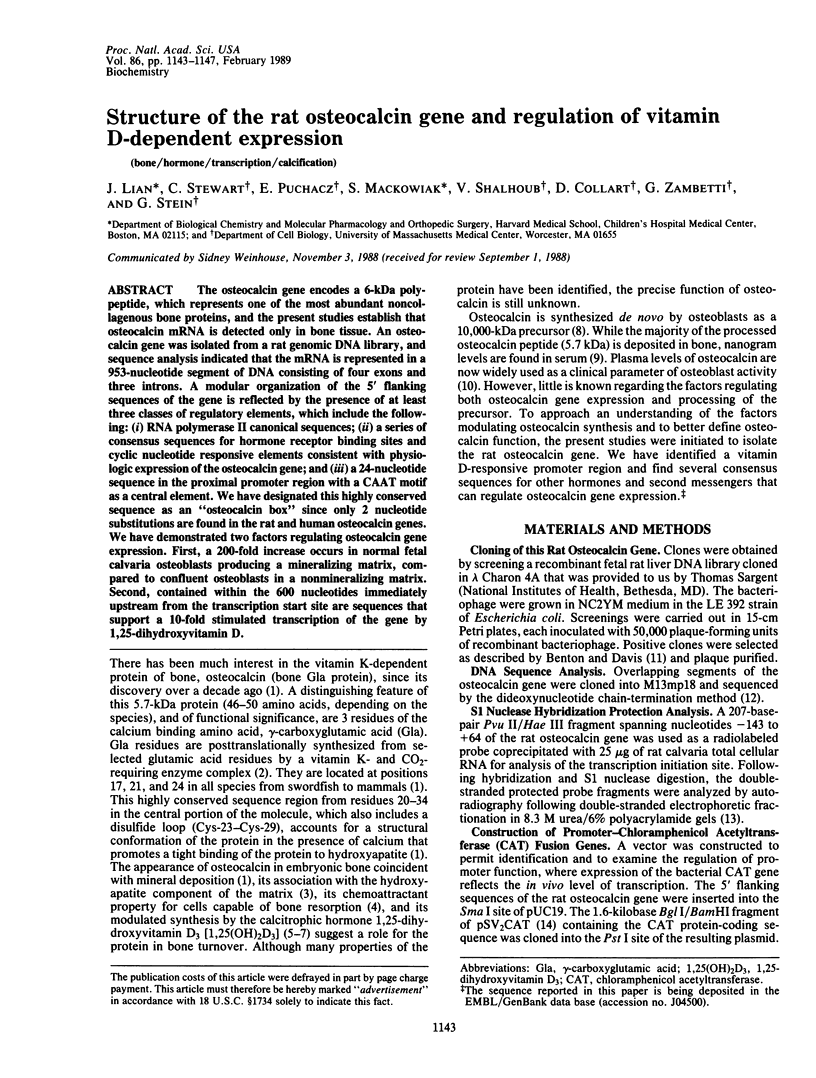

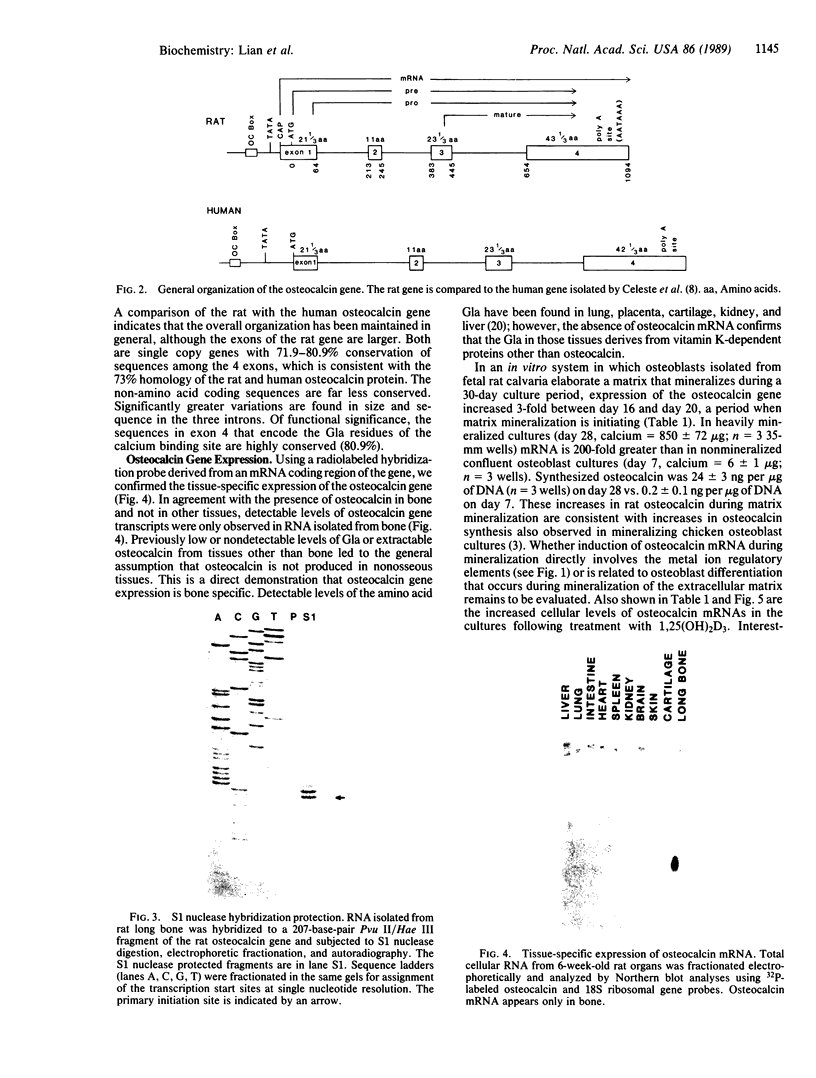
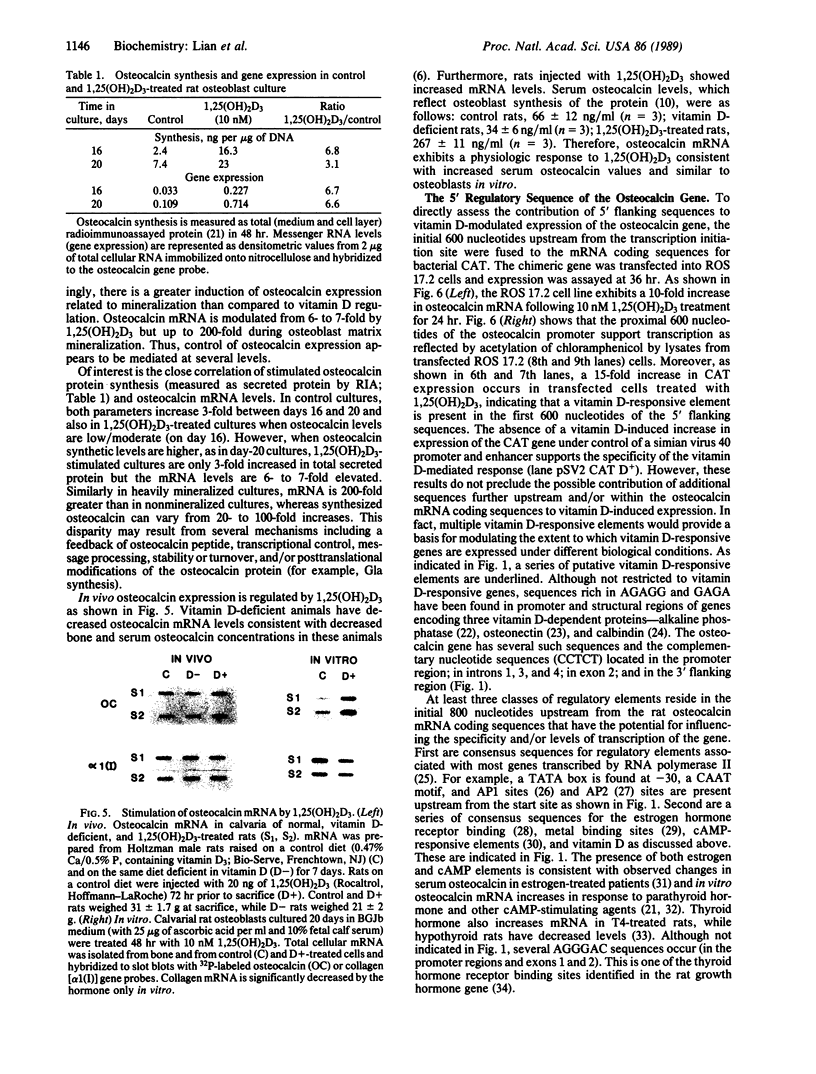
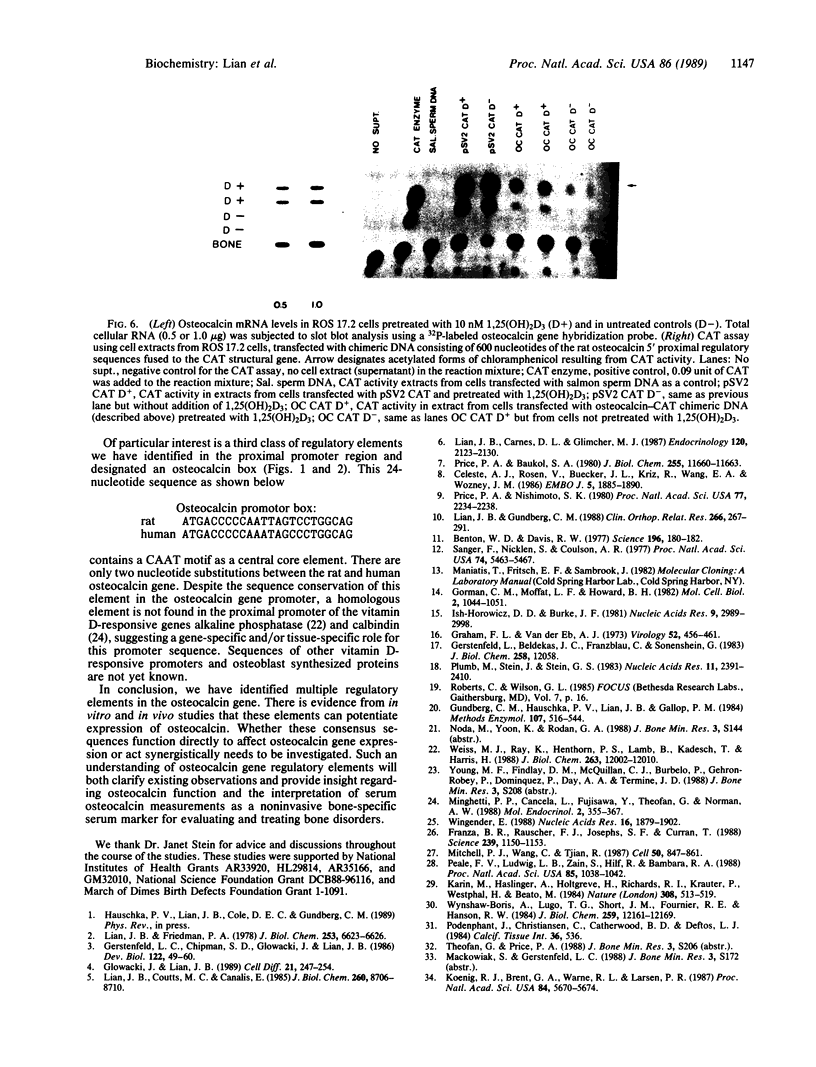
Images in this article
Selected References
These references are in PubMed. This may not be the complete list of references from this article.
- Benton W. D., Davis R. W. Screening lambdagt recombinant clones by hybridization to single plaques in situ. Science. 1977 Apr 8;196(4286):180–182. doi: 10.1126/science.322279. [DOI] [PubMed] [Google Scholar]
- Celeste A. J., Rosen V., Buecker J. L., Kriz R., Wang E. A., Wozney J. M. Isolation of the human gene for bone gla protein utilizing mouse and rat cDNA clones. EMBO J. 1986 Aug;5(8):1885–1890. doi: 10.1002/j.1460-2075.1986.tb04440.x. [DOI] [PMC free article] [PubMed] [Google Scholar]
- Franza B. R., Jr, Rauscher F. J., 3rd, Josephs S. F., Curran T. The Fos complex and Fos-related antigens recognize sequence elements that contain AP-1 binding sites. Science. 1988 Mar 4;239(4844):1150–1153. doi: 10.1126/science.2964084. [DOI] [PubMed] [Google Scholar]
- Gerstenfeld L. C., Chipman S. D., Glowacki J., Lian J. B. Expression of differentiated function by mineralizing cultures of chicken osteoblasts. Dev Biol. 1987 Jul;122(1):49–60. doi: 10.1016/0012-1606(87)90331-9. [DOI] [PubMed] [Google Scholar]
- Gerstenfeld L., Beldekas J. C., Franzblau C., Sonenshein G. E. Cell-free translation of calf type III collagen. Effect of magnesium on ribosome movement during elongation. J Biol Chem. 1983 Oct 10;258(19):12058–12063. [PubMed] [Google Scholar]
- Glowacki J., Lian J. B. Impaired recruitment and differentiation of osteoclast progenitors by osteocalcin-deplete bone implants. Cell Differ. 1987 Sep;21(4):247–254. doi: 10.1016/0045-6039(87)90479-9. [DOI] [PubMed] [Google Scholar]
- Gorman C. M., Moffat L. F., Howard B. H. Recombinant genomes which express chloramphenicol acetyltransferase in mammalian cells. Mol Cell Biol. 1982 Sep;2(9):1044–1051. doi: 10.1128/mcb.2.9.1044. [DOI] [PMC free article] [PubMed] [Google Scholar]
- Graham F. L., van der Eb A. J. A new technique for the assay of infectivity of human adenovirus 5 DNA. Virology. 1973 Apr;52(2):456–467. doi: 10.1016/0042-6822(73)90341-3. [DOI] [PubMed] [Google Scholar]
- Gundberg C. M., Hauschka P. V., Lian J. B., Gallop P. M. Osteocalcin: isolation, characterization, and detection. Methods Enzymol. 1984;107:516–544. doi: 10.1016/0076-6879(84)07036-1. [DOI] [PubMed] [Google Scholar]
- Ish-Horowicz D., Burke J. F. Rapid and efficient cosmid cloning. Nucleic Acids Res. 1981 Jul 10;9(13):2989–2998. doi: 10.1093/nar/9.13.2989. [DOI] [PMC free article] [PubMed] [Google Scholar]
- Karin M., Haslinger A., Holtgreve H., Richards R. I., Krauter P., Westphal H. M., Beato M. Characterization of DNA sequences through which cadmium and glucocorticoid hormones induce human metallothionein-IIA gene. Nature. 1984 Apr 5;308(5959):513–519. doi: 10.1038/308513a0. [DOI] [PubMed] [Google Scholar]
- Koenig R. J., Brent G. A., Warne R. L., Larsen P. R., Moore D. D. Thyroid hormone receptor binds to a site in the rat growth hormone promoter required for induction by thyroid hormone. Proc Natl Acad Sci U S A. 1987 Aug;84(16):5670–5674. doi: 10.1073/pnas.84.16.5670. [DOI] [PMC free article] [PubMed] [Google Scholar]
- Lian J. B., Carnes D. L., Glimcher M. J. Bone and serum concentrations of osteocalcin as a function of 1,25-dihydroxyvitamin D3 circulating levels in bone disorders in rats. Endocrinology. 1987 May;120(5):2123–2130. doi: 10.1210/endo-120-5-2123. [DOI] [PubMed] [Google Scholar]
- Lian J. B., Coutts M., Canalis E. Studies of hormonal regulation of osteocalcin synthesis in cultured fetal rat calvariae. J Biol Chem. 1985 Jul 25;260(15):8706–8710. [PubMed] [Google Scholar]
- Lian J. B., Friedman P. A. The vitamin K-dependent synthesis of gamma-carboxyglutamic acid by bone microsomes. J Biol Chem. 1978 Oct 10;253(19):6623–6626. [PubMed] [Google Scholar]
- Lian J. B., Gundberg C. M. Osteocalcin. Biochemical considerations and clinical applications. Clin Orthop Relat Res. 1988 Jan;(226):267–291. [PubMed] [Google Scholar]
- Minghetti P. P., Cancela L., Fujisawa Y., Theofan G., Norman A. W. Molecular structure of the chicken vitamin D-induced calbindin-D28K gene reveals eleven exons, six Ca2+-binding domains, and numerous promoter regulatory elements. Mol Endocrinol. 1988 Apr;2(4):355–367. doi: 10.1210/mend-2-4-355. [DOI] [PubMed] [Google Scholar]
- Mitchell P. J., Wang C., Tjian R. Positive and negative regulation of transcription in vitro: enhancer-binding protein AP-2 is inhibited by SV40 T antigen. Cell. 1987 Sep 11;50(6):847–861. doi: 10.1016/0092-8674(87)90512-5. [DOI] [PubMed] [Google Scholar]
- Peale F. V., Jr, Ludwig L. B., Zain S., Hilf R., Bambara R. A. Properties of a high-affinity DNA binding site for estrogen receptor. Proc Natl Acad Sci U S A. 1988 Feb;85(4):1038–1042. doi: 10.1073/pnas.85.4.1038. [DOI] [PMC free article] [PubMed] [Google Scholar]
- Plumb M., Stein J., Stein G. Coordinate regulation of multiple histone mRNAs during the cell cycle in HeLa cells. Nucleic Acids Res. 1983 Apr 25;11(8):2391–2410. doi: 10.1093/nar/11.8.2391. [DOI] [PMC free article] [PubMed] [Google Scholar]
- Price P. A., Baukol S. A. 1,25-Dihydroxyvitamin D3 increases synthesis of the vitamin K-dependent bone protein by osteosarcoma cells. J Biol Chem. 1980 Dec 25;255(24):11660–11663. [PubMed] [Google Scholar]
- Price P. A., Nishimoto S. K. Radioimmunoassay for the vitamin K-dependent protein of bone and its discovery in plasma. Proc Natl Acad Sci U S A. 1980 Apr;77(4):2234–2238. doi: 10.1073/pnas.77.4.2234. [DOI] [PMC free article] [PubMed] [Google Scholar]
- Pødenphant J., Christiansen C., Catherwood B. D., Deftos L. J. Serum bone Gla protein variations during estrogen and calcium prophylaxis of postmenopausal women. Calcif Tissue Int. 1984 Sep;36(5):536–540. doi: 10.1007/BF02405361. [DOI] [PubMed] [Google Scholar]
- Sanger F., Nicklen S., Coulson A. R. DNA sequencing with chain-terminating inhibitors. Proc Natl Acad Sci U S A. 1977 Dec;74(12):5463–5467. doi: 10.1073/pnas.74.12.5463. [DOI] [PMC free article] [PubMed] [Google Scholar]
- Weiss M. J., Ray K., Henthorn P. S., Lamb B., Kadesch T., Harris H. Structure of the human liver/bone/kidney alkaline phosphatase gene. J Biol Chem. 1988 Aug 25;263(24):12002–12010. [PubMed] [Google Scholar]
- Wingender E. Compilation of transcription regulating proteins. Nucleic Acids Res. 1988 Mar 25;16(5):1879–1902. doi: 10.1093/nar/16.5.1879. [DOI] [PMC free article] [PubMed] [Google Scholar]
- Wynshaw-Boris A., Lugo T. G., Short J. M., Fournier R. E., Hanson R. W. Identification of a cAMP regulatory region in the gene for rat cytosolic phosphoenolpyruvate carboxykinase (GTP). Use of chimeric genes transfected into hepatoma cells. J Biol Chem. 1984 Oct 10;259(19):12161–12169. [PubMed] [Google Scholar]



